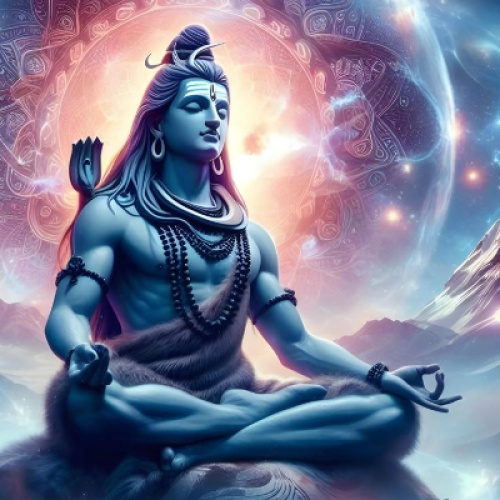The Story of Lord Shiva
In the vast tapestry of Hindu mythology, Lord Shiva stands as one of the principal deities of the Trimurti, alongside Brahma, the creator, and Vishnu, the preserver. He represents the force of destruction, but this destruction is not merely one of annihilation; it is also about creation and regeneration. His story is rich with symbolism, depth, and profound teachings.
Origins
Lord Shiva is often referred to as the auspicious one. He is believed to be timeless and eternal, beyond the confines of time and space. According to some ancient texts, Shiva emerged from the cosmic waters when the universe was yet unformed. In other tales, he is said to be the son of Lord Brahma and Goddess Durga, or in some traditions, he is an avatar of the formless supreme consciousness, a manifestation of the ultimate reality known as Brahman.
Appearance
Shiva's form is striking and filled with symbolism. He has a blue throat, a result of swallowing poison during the churning of the ocean (Samudra Manthan) when gods and demons sought the nectar of immortality. This act saved the universe from destruction and represents his role as a protector.
His matted hair (jata) symbolizes asceticism and control over the mind. The crescent moon perched upon his head signifies time, and as the moon waxes and wanes, it reflects the cycle of creation and destruction. He bears a third eye on his forehead, which represents higher perception and insight - when opened, it can destroy ignorance and reveal truth.
The Cosmic Dancer
One of the most famous aspects of Shiva is his role as Nataraja, the cosmic dancer. In this form, he performs the Tandava, a celestial dance that represents the cycle of creation, preservation, and destruction of the universe. This rhythm brings about cosmic balance, illustrating the interplay between opposing forces in existence.
His Consort and Family
Shiva is married to Parvati, the daughter of the mountain king Himavan and queen Mena. Parvati's love and devotion helped to temper Shiva's ascetic nature. Together, they have two children: Ganesha, the elephant-headed god known as the remover of obstacles, and Kartikeya, the god of war.
Their love story is filled with trials and devotion. After his intense meditation and ascetic lifestyle, Parvati undertakes severe penance to gain Shiva's love, ultimately succeeding in rekindling their bond.
The Legends of Shiva
Shiva is the subject of many legends that depict his various aspects and deeds. One prominent story is the Brahma-Vishnu Disconnect, where Brahma and Vishnu argue over who is greater. To resolve this, Shiva manifests as an enormous pillar of light, challenging them to find its ends. While Vishnu ultimately humbles himself, Brahma tries to deceive Shiva to declare himself superior, resulting in Brahma being cursed to never be worshipped as a divine figure.
Another famous tale is the Churning of the Ocean (Samudra Manthan). In this myth, the gods and demons churn the ocean to obtain the nectar of immortality. A lethal poison rises from the ocean, threatening all of creation. Shiva selflessly drinks the poison to save the universe, holding it in his throat, which turned blue.
Symbolism and Teachings
Shiva embodies paradoxes - the ascetic and the householder, the destroyer and the creator, the passive and the active. His teachings center around the importance of balance in life, the acceptance of dualities, and the understanding of the nature of reality.
His followers, known as Shaivites, often meditate upon Shiva, contemplating his nature as a means to realize the true self and connect with the divine.
Worship
Shiva is worshipped in various forms, with the Shivling being a prominent representation. Pilgrims flock to sacred sites such as the Kashi Vishwanath Temple in Varanasi and the Kedarnath Temple in the Himalayas, where they offer prayers and observe rituals.
Shivaratri, the great night of Shiva, is a significant festival celebrated by millions, marked by fasting and night-long vigils that honor his power and presence.
Conclusion
The story of Shiva is one of profound wisdom and cosmic significance. He is not just a deity of destruction; he represents transformation, balance, and the essence of life itself. Shiva invites his devotees to look beyond the surface, embrace change, and recognize the divine within themselves and the universe.
In the vast tapestry of Hindu mythology, Lord Shiva stands as one of the principal deities of the Trimurti, alongside Brahma, the creator, and Vishnu, the preserver. He represents the force of destruction, but this destruction is not merely one of annihilation; it is also about creation and regeneration. His story is rich with symbolism, depth, and profound teachings.
Origins
Lord Shiva is often referred to as the auspicious one. He is believed to be timeless and eternal, beyond the confines of time and space. According to some ancient texts, Shiva emerged from the cosmic waters when the universe was yet unformed. In other tales, he is said to be the son of Lord Brahma and Goddess Durga, or in some traditions, he is an avatar of the formless supreme consciousness, a manifestation of the ultimate reality known as Brahman.
Appearance
Shiva's form is striking and filled with symbolism. He has a blue throat, a result of swallowing poison during the churning of the ocean (Samudra Manthan) when gods and demons sought the nectar of immortality. This act saved the universe from destruction and represents his role as a protector.
His matted hair (jata) symbolizes asceticism and control over the mind. The crescent moon perched upon his head signifies time, and as the moon waxes and wanes, it reflects the cycle of creation and destruction. He bears a third eye on his forehead, which represents higher perception and insight - when opened, it can destroy ignorance and reveal truth.
The Cosmic Dancer
One of the most famous aspects of Shiva is his role as Nataraja, the cosmic dancer. In this form, he performs the Tandava, a celestial dance that represents the cycle of creation, preservation, and destruction of the universe. This rhythm brings about cosmic balance, illustrating the interplay between opposing forces in existence.
His Consort and Family
Shiva is married to Parvati, the daughter of the mountain king Himavan and queen Mena. Parvati's love and devotion helped to temper Shiva's ascetic nature. Together, they have two children: Ganesha, the elephant-headed god known as the remover of obstacles, and Kartikeya, the god of war.
Their love story is filled with trials and devotion. After his intense meditation and ascetic lifestyle, Parvati undertakes severe penance to gain Shiva's love, ultimately succeeding in rekindling their bond.
The Legends of Shiva
Shiva is the subject of many legends that depict his various aspects and deeds. One prominent story is the Brahma-Vishnu Disconnect, where Brahma and Vishnu argue over who is greater. To resolve this, Shiva manifests as an enormous pillar of light, challenging them to find its ends. While Vishnu ultimately humbles himself, Brahma tries to deceive Shiva to declare himself superior, resulting in Brahma being cursed to never be worshipped as a divine figure.
Another famous tale is the Churning of the Ocean (Samudra Manthan). In this myth, the gods and demons churn the ocean to obtain the nectar of immortality. A lethal poison rises from the ocean, threatening all of creation. Shiva selflessly drinks the poison to save the universe, holding it in his throat, which turned blue.
Symbolism and Teachings
Shiva embodies paradoxes - the ascetic and the householder, the destroyer and the creator, the passive and the active. His teachings center around the importance of balance in life, the acceptance of dualities, and the understanding of the nature of reality.
His followers, known as Shaivites, often meditate upon Shiva, contemplating his nature as a means to realize the true self and connect with the divine.
Worship
Shiva is worshipped in various forms, with the Shivling being a prominent representation. Pilgrims flock to sacred sites such as the Kashi Vishwanath Temple in Varanasi and the Kedarnath Temple in the Himalayas, where they offer prayers and observe rituals.
Shivaratri, the great night of Shiva, is a significant festival celebrated by millions, marked by fasting and night-long vigils that honor his power and presence.
Conclusion
The story of Shiva is one of profound wisdom and cosmic significance. He is not just a deity of destruction; he represents transformation, balance, and the essence of life itself. Shiva invites his devotees to look beyond the surface, embrace change, and recognize the divine within themselves and the universe.





